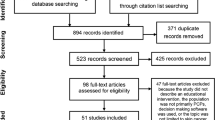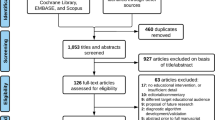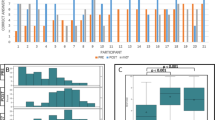Abstract
Primary care visits provide an opportunity for skin examinations with the potential to reduce melanoma mortality. The INFORMED (INternet curriculum FOR Melanoma Early Detection) Group developed a Web-based curriculum to improve primary care providers’ (PCPs’) skin cancer detection skills. This study details feedback obtained from participant focus groups, including the feasibility of implementing in other PCP practices. Practicing PCPs at Henry Ford Health System and Kaiser Permanente Northern California completed the curriculum. Feedback sessions were conducted with standardized questions focusing on four domains: (1) overall impressions of the curriculum, (2) recommendations for improvement, (3) current skin examination practices, and (4) suggestions for increasing skin screening by PCPs. Discussions at each site were audio recorded, transcribed verbatim, and de-identified. Providers (N = 54) had a positive impression of the Web-based curriculum, with suggestions to provide offline teaching aids and request assistance. Despite having improved confidence in diagnosing malignant lesions, many providers felt a lack of confidence in performing the screening and time constraints affected their current practices, as did institutional constraints. Providers intended to increase discussion with patients about skin cancer. The accessibility, effectiveness, and popularity of the curriculum indicate potential for implementation in the primary care setting. Participating providers noted that institutional barriers remain which must be addressed for successful dissemination and implementation.
Similar content being viewed by others
References
American Cancer Society (2014) Cancer facts and figures 2014. American Cancer Society, Atlanta
Anderson RT, Dziak K, McBride J, Camacho F, Hege AC, Torti FM (2004) Demand for continuing medical education programs on cancer care among primary care physicians in North Carolina. N C Med J 65(3):130–135
Borkan J (1999) Immersion/crystallization. In: Crabtree BF, Miller WL (eds) Doing qualitative research. Sage, Thousand Oaks, pp 179–194
Carli P, De Giorgi V, Crocetti E, Caldini L, Ressel C, Giannotti B (2005) Diagnostic and referral accuracy of family doctors in melanoma screening: effect of a short formal training. Eur J Cancer Prev 14(1):51–55
Cook DA (2007) Web-based learning: pros, cons and controversies. Clin Med (London, England) 7(1):37–42
Dobbins M, Cockerill R, Barnsley J, Ciliska D (2001) Factors of the innovation, organization, environment, and individual that predict the influence five systematic reviews had on public health decisions. Int J Technol Assess Health Care 17(4):467–478
Eide MJ, Asgari MM, Fletcher SW, Geller AC, Halpern AC, Shaikh WR, Li L et al (2013) Effects on skills and practice from a web-based skin cancer course for primary care providers. J Am Board Family Med 26(6):648–657
Estabrooks CA, Floyd JA, Scott-Findlay S, O’Leary KA, Gushta M (2003) Individual determinants of research utilization: a systematic review. J Adv Nurs 43(5):506–520
Feldman SR, Fleischer AB Jr (2000) Skin examinations and skin cancer prevention counseling by US physicians: a long way to go. J Am Acad Dermatol 43(2 Pt 1):234–237. doi:10.1067/mjd.2000.105559
Garrido Elustondo S, Garcia Vallejo R, Nogales Aguado P (2002) Continuing education in primary care: the educational needs of its professionals. Aten Primaria 30(6):368–373
Gerbert B, Bronstone A, Wolff M, Maurer T, Berger T, Pantilat S, McPhee SJ (1998) Improving primary care residents’ proficiency in the diagnosis of skin cancer. J Gen Intern Med 13(2):91–97
Gerbert B, Maurer T, Berger T, Pantilat S, McPhee SJ, Wolff M, Bronstone A, Caspers N (1996) Primary care physicians as gatekeepers in managed care. Primary care physicians’ and dermatologists’ skills at secondary prevention of skin cancer. Arch Dermatol 132(9):1030–1038
Gerbert B, Bronstone A, Maurer T, Berger T, McPhee SJ, Caspers N (2002) The effectiveness of an internet-based tutorial in improving primary care physicians’ skin cancer triage skills. J Cancer Educ 17(1):7–11
Goulart JM, Quigley EA, Dusza S, Jewell ST, Alexander G, Asgari MM, Eide MJ et al (2011) Skin cancer education for primary care physicians: a systematic review of published evaluated interventions. J Gen Intern Med 26(9):1027–1035
Katalinic A, Waldmann A, Weinstock MA, Geller AC, Eisemann N, Greinert R, Volkmer B, Breitbart E (2012) Does skin cancer screening save lives?: an observational study comparing trends in melanoma mortality in regions with and without screening. Cancer 118(21):5395–5402
Kirsner RS, Muhkerjee S, Federman DG (1999) Skin cancer screening in primary care: prevalence and barriers. J Am Acad Dermatol 41(4):564–566
Lasser KE, Ayanian JZ, Fletcher RH, Del Vecchio Good M-J (2008) Barriers to colorectal cancer screening in community health centers: a qualitative study. BMC Fam Pract 9:15
Lobb R, Colditz GA (2013) Implementation science and its application to population health. Annu Rev Public Health 34:235–251
Martinez-Gutierrez J, Jhingan E, Angulo A, Jimenez R, Thompson B, Coronado GD (2013) Cancer screening at a federally qualified health center: a qualitative study on organizational challenges in the era of the patient-centered medical home. J Immigr Minor Health 15(5):993–1000
Milat AJ, King L, Bauman AE, Redman S (2013) The concept of scalability: increasing the scale and potential adoption of health promotion interventions into policy and practice. Health Promot Int 28(3):285–298
Rabin BA, Nehl E, Elliott T, Deshpande AD, Brownson RC, Glanz K (2010) Individual and setting level predictors of the implementation of a skin cancer prevention program: a multilevel analysis. Implement Sci 5:40
Rohrbach LA, Grana R, Sussman S, Valente TW (2006) Type II translation: transporting prevention interventions from research to real-world settings. Evaluation Health Professions 29(3):302–333
Siegel RL, Miller KD, Jemal A (2015) Cancer statistics, 2015. CA Cancer J Clin 65(1):5–29. doi:10.3322/caac.21254
US Department of Health and Human Services (2014) The surgeon general’s call to action to prevent skin cancer. Washington, DC: US Department of Health and Human Services, Office of the Surgeon General
Wagner EH, Greene SM, Hart G, Field TS, Fletcher S, Geiger AM, Herrinton LJ et al. (2005) Building a research consortium of large health systems: the Cancer Research Network. J Natl Cancer Institute. Monographs (35):3-11. doi: 10.1093/jncimonographs/lgi032
Acknowledgments
This study was developed by the INFORMED (Internet Course of Melanoma Early Detection) Group, which, in addition to the authors listed, includes Waqas Shaikh, MD MPH; Lingling Li, PhD; Stephen Dusza, DrPH; Ashfaq Marghoob, MD; Elizabeth Quigley, MD; Jacqueline M. Goulart, MD; Shoshana Landow, MD; Michelle Groesbeck, BS; Richard Krajenta, MS; Kimberly Marcolivio, MEd; Monica Sokil, RD; and E. Margaret Warton, MPH.
Conflict of Interest
The authors declared that they have no competing interests.
Funding Sources
This study was funded by a Team Science Award from the Melanoma Research Alliance, with the National Cancer Institute-supported HMO Cancer Research Network (U24 CA171524) and National Cancer Institute-mentored Training for Dissemination and Implementation Research (R25 CA171994). The sponsors had no role in the design and conduct of the study; in the collection, analysis, and interpretation of data; or in the preparation, review, or approval of the manuscript.
Author information
Authors and Affiliations
Corresponding author
Rights and permissions
About this article
Cite this article
Jiang, A.J., Eide, M.J., Alexander, G.L. et al. Providers’ Experiences with a Melanoma Web-Based Course: a Discussion on Barriers and Intentions. J Canc Educ 32, 272–279 (2017). https://doi.org/10.1007/s13187-015-0910-4
Published:
Issue Date:
DOI: https://doi.org/10.1007/s13187-015-0910-4




